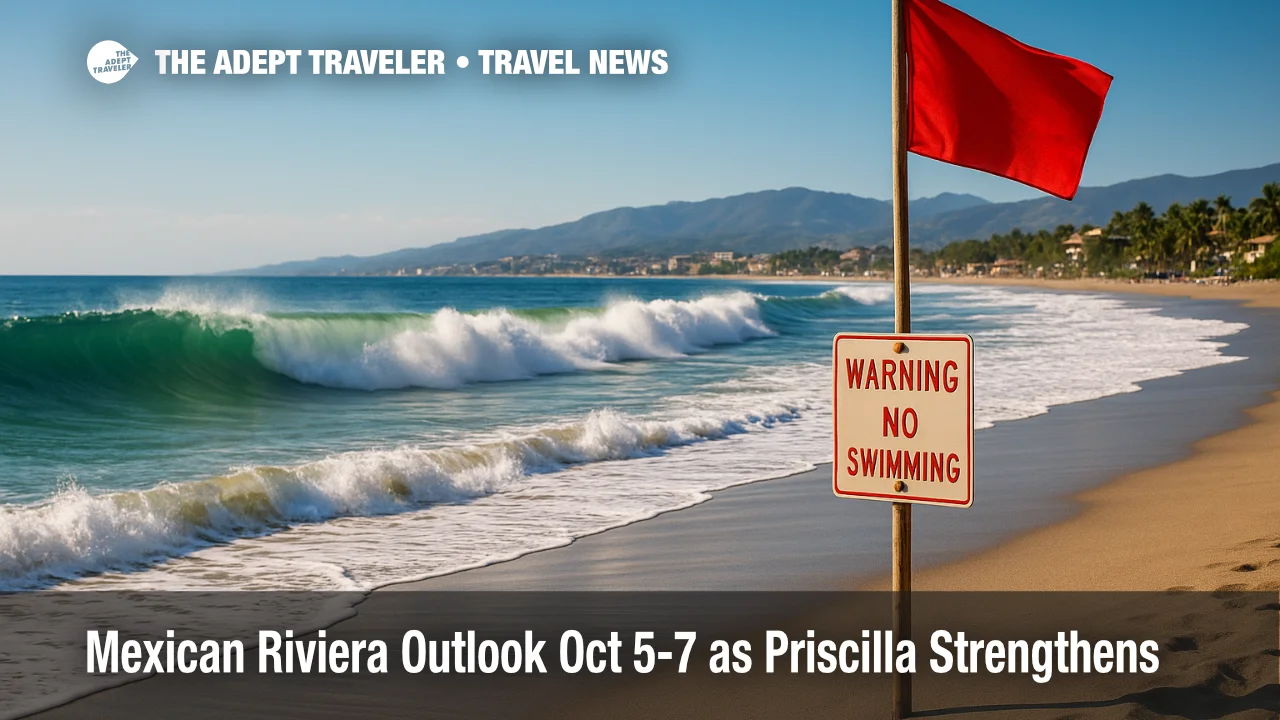Mexican Riviera outlook: October 5-7 as Priscilla strengthens

A strengthening Tropical Storm Priscilla in the Eastern Pacific will keep the Mexican Riviera under elevated surf, rip currents, and periods of squally rain through October 7. While the center is forecast to track parallel to the coast, hazards extend far from the core. Cruise tenders at exposed anchorages such as Cabo San Lucas may pause during peak sets, and officials have hoisted beach warnings around Bahía de Banderas, including Puerto Vallarta and Riviera Nayarit. Guests should watch cruise-line apps for same-day port-time adjustments, and beachgoers should follow lifeguard directions.
Read Yesterday's Article: Tropical Storm Priscilla off Mexico's Pacific coast
Key Points
- Why it matters: Swell and rip currents will challenge beach time and ship-to-shore tendering.
- Travel impact: Cabo tenders may pause; Bahia de Banderas beaches face ongoing red-flag periods.
- What's next: Priscilla could reach hurricane strength late October 5 or October 6, then move northwest offshore.
- NHC watches extend from Punta San Telmo to Punta Mita; rain bands may be locally heavy.
- Expect on-and-off showers, brief gusts, and rough surf through Tuesday.
Snapshot
From October 5 to 7, long-period south to southwest swell and intermittent squalls will continue along the Mexican Riviera. The National Hurricane Center says Priscilla's tropical-storm-force winds extend outward a considerable distance, increasing surf and rip-current risk well away from the center. A Tropical Storm Watch covers portions of the coast from Punta San Telmo to Punta Mita, which includes the broader Bahía de Banderas region. Beach authorities around Puerto Vallarta have posted red flags at multiple beaches in recent days, and those warnings may persist or toggle during tide and set changes. Cruise ships calling at Cabo San Lucas, an exposed anchorage, should plan for tender slowdowns during peak swell.
Background
Eastern Pacific systems commonly run northwest along Mexico's coast in October, sending long-period swell into the Mexican Riviera. When storms parallel the shoreline, the main hazards for travelers are rough surf, dangerous rip currents, brief downpours, and localized coastal flooding during high tide. These conditions can disrupt cruise tenders at open-roadstead ports and close popular swim beaches. In Bahía de Banderas, Puerto Vallarta's lifeguards use red flags to denote no-swim conditions when sets and currents build. Even if the storm's core remains offshore, persistent swell can keep warnings up through several tide cycles. Nearby, Riviera Nayarit's exposed beaches and points also feel enhanced surf and rip currents under this pattern.
Latest Developments
Mexican Riviera beaches and cruise calls: What to expect October 5-7
As of early October 5, Priscilla was strengthening with maximum sustained winds near 65 mph and a broad wind field. The NHC expects additional strengthening, possibly to hurricane intensity late October 5 into October 6, with the track remaining generally parallel to the coast. A Tropical Storm Watch is in effect from Punta San Telmo to Punta Mita, signaling the potential for tropical-storm conditions and dangerous marine hazards. Around Puerto Vallarta, authorities have recently maintained red-flag closures at many beaches due to persistent high surf and strong return currents, and these restrictions may continue to toggle as sets pulse. Cabo San Lucas can experience tender halts during larger sets; lines typically adjust shore time accordingly. Travelers should follow official lifeguard guidance, avoid rock-lined headlands, and expect rain bands with brief gusts during the afternoon and evening periods.
Analysis
For travelers, the practical risk through October 7 is less about direct wind damage and more about marine exposure. The combination of a large storm envelope and parallel coastal track favors prolonged swell and long-shore currents in Bahía de Banderas and along the open beaches of Riviera Nayarit. Even skilled swimmers can be caught by rip currents or shore-break; red flags are the clearest cue to stay out. On the cruise side, Cabo San Lucas relies on ship-to-shore tenders at an unprotected anchorage, which are sensitive to set waves. When sets spike, tender operations slow or pause, compressing shore time and occasionally prompting schedule tweaks. Expect captains to reassess conditions hourly and keep guests updated via apps and onboard announcements. Inland excursions generally proceed, but plan for wet roads, slippery steps at viewpoints, and sporadic bursts of heavy rain. If you are flying in for embarkation, build extra transfer time between airport arrivals and pier shuttles to buffer against rain-related traffic.
Final Thoughts
From Sunday through Tuesday, the safest approach along the Mexican Riviera is conservative beach use and flexible plans. Heed lifeguards, skip cliffside or rock outcrops during high tide, and watch your line's app for any tender timing updates in Cabo. Expect scenic cloud bands and passing showers, but also respect the power of long-period swell. If conditions improve ahead of schedule, flags will drop and tenders will resume quickly. Until then, prioritize safety, adapt your shore plans, and keep an eye on official updates tied to this Mexican Riviera outlook.
